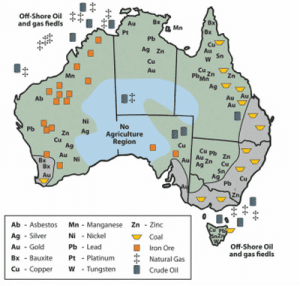TAG: GS 1: WORLD GEOGRAPHY
THE CONTEXT: Australia took steps to ban mining at an Indigenous site surrounded by Kakadu National Park, which is home to one of the world’s largest deposits of high-grade uranium.
EXPLANATION:
- This decision marks a major victory for the Mirarr people, who have fought for decades to protect their land from exploitation by mining companies.
- Prime Minister announced the extension of the heritage-listed Kakadu National Park to include the Jabiluka site, ensuring it remains free from mining activities.
- This move aligns with the long-standing wishes of the Mirarr people, who have sought guarantees that uranium mining would never occur on their land.
- PM emphasized the historical and cultural significance of the area, highlighting its enduring connection to Aboriginal and Torres Strait Islanders.

Natural resources in Australia
Historical and Cultural Significance
- The Jabiluka site gained considerable attention in 2017 when archaeologists discovered a buried trove of stone axes and tools nearby, dating them back tens of thousands of years.
- This discovery underscored the deep historical connection of the Indigenous people to the land, further justifying the need for its protection.
- Prime Minister reiterated the government’s commitment to preserving the site in line with the desires of the Mirarr people.
- “They were seeking a guarantee that there would never be uranium mining on their land,” PM told supporters in Sydney.
- It was assured that with the park’s extension, “there will never be mining at Jabiluka,” emphasizing the extraordinary and enduring connection Indigenous Australians have with their land.
- “The Mirarr people have loved and cared for their land for more than 60,000 years. Our government will work with them to keep it safe for all time,” he added.
Political Context
- This move comes at a time when the opposition conservative Coalition has announced plans to build nuclear power plants across Australia if it wins the next election, proposing to overturn a 26-year nuclear ban.
- The government’s decision to protect Jabiluka may also be seen as a response to growing concerns about the conservation of Indigenous sites, especially after the controversial destruction of the Juukan Gorge rock shelters by Rio Tinto in 2020.
The Long Battle for Jabiluka
- The discovery of uranium at Jabiluka in the early 1970s sparked a prolonged conflict between the Mirarr people and mining companies.
- The site became a focal point for legal battles and protests, including a notable blockade in the late 1990s supported by the rock band Midnight Oil.
- Energy Resources of Australia (ERA) previously held mining leases at Jabiluka, which will not be extended beyond their expiration on August 11.
Recent Events and Global Reactions
- The decision to protect Jabiluka is influenced by the global outcry following the legal destruction of the Juukan Gorge rock shelters, which were 46,000 years old.
- This incident brought international attention to the importance of conserving Indigenous heritage sites in Australia.
- The protection of Jabiluka is a significant step in preventing similar incidents and respecting the cultural heritage of the Indigenous population.
Cultural Impact
- The Kakadu National Park, which now includes the protected Jabiluka site, has also gained cultural significance from its appearance in the popular 1986 Australian comedy film “Crocodile Dundee.”
- This added a layer of recognition to the park, making its preservation even more important on a national and international level.

